The modern-day African Great Lakes state of Tanzania dates formally from 1964, when it was formed out of the union of the much larger mainland territory of Tanganyika and the coastal archipelago of Zanzibar. The former was a colony and part of German East Africa from the 1880s to 1919 when, under the League of Nations, it became a British mandate. It served as a British mir II]], providing financial help, munitions, and soldiers. In 1947, Tanganyika became a United Nations Trust Territory under British administration, a status it kept until its independence in 1961. The island of Zanzibar thrived as a trading hub, successively controlled by the Portuguese, the Sultanate of Oman, and then as a British protectorate by the end of the nineteenth century.

Ujiji is the oldest town in western Tanzania and is located in Kigoma-Ujiji District of Kigoma Region. Originally a Swahili settlement and then an Arab slave trading post by the mid-nineteenth century nominally under the Sultanate of Zanzibar, the town is the oldest in western Tanzania. In 1900, the population was estimated at 10,000 and in 1967 about 41,000. The site is a registered National Historic Site.

Kigoma is a city and lake port in Kigoma-Ujiji District in Tanzania, on the northeastern shores of Lake Tanganyika and close to the border with Burundi and The Democratic Republic of the Congo. It serves as the capital for the surrounding Kigoma Region and has a population of 232,388. The city is situated at an elevation of 775 metres (2,543 ft).

Kigoma Region is one of Tanzania's 31 administrative regions, with the city of Kigoma as the reigonal capital. Kigoma Region borders Kagera Region, Geita Region, Katavi Region, Tabora Region, DRC and Burundi According to the 2012 national census, the region had a population of 2,127,930, which was higher than the pre-census projection of 1,971,332. For 2002–2012, the region's 2.4 percent average annual population growth rate was tied for the fourteenth highest in the country. It was also the sixteenth most densely populated region with 57 people per square kilometer. With a size of 45,066 square kilometres (17,400 sq mi), the region is slightly smaller than Estonia.
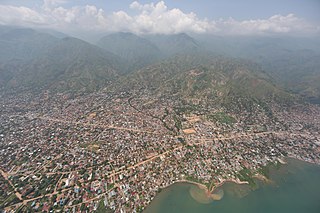
Uvira is a city strategically located in the South Kivu Province of the eastern region of the Democratic Republic of the Congo. Covering approximately 16 square kilometers and with an estimated population of 726,000 as of 2024, it borders Bafuliru Chiefdom and Ruzizi Plain Chiefdom to the north, Bavira Chiefdom to the south, and Lake Tanganyika and the Ruzizi River to the east. These rivers form natural boundaries between the DRC and Burundi. Located in the Ruzizi Plain at a low altitude, the city lies between Burundi's Congo-Nile ridge and the Mitumba mountains.
Kalemie, formerly Albertville or Albertstad, is a city on the western shore of Lake Tanganyika in the Democratic Republic of the Congo. The Lukuga River, that drains Lake Tanganyika to the Lualaba River, runs through the city. Kalemie is the capital of Tanganyika Province.
Unyamwezi is a historical region in what is now Tanzania, around the modern city of Tabora to the south of Lake Victoria and east of Lake Tanganyika. It lay on the trade route from the coast to Lake Tanganyika and to the kingdoms to the west of Lake Victoria. The various peoples of the region were known as long-distance traders, providing porters for caravans and arranging caravans in their own right. At first the main trade was in ivory, but later slaving became more important.
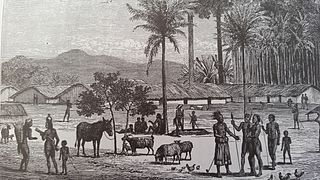
Manyema (WaManyema) (Una-Ma-Nyema, eaters of flesh) are a Bantu ethnic group, described in the past as powerful and warlike, in the African Great Lakes region of Eastern Africa and Central Africa.
Jiji people also known as Bajiji are a Bantu ethnic and linguistic group based in Kigoma Region, Tanzania. If tribes are classified by language and not by race, Bajiji are part of Baha since their language is the same. Traditionally they were organized into a separate kingdom, Bujiji, and formed part of Buha with other kingdoms: Heru, Bushingo (Ushingo), Ruguru (Luguru), Muhambwe and Buyungu, all of them in Kigoma Region, Tanzania.

The Ha, also called Abaha, are a Bantu ethnic group found in Kigoma Region in northwestern Tanzania bordering Lake Tanganyika. In 2001, the Ha population was estimated to number between 1 and 1.5 million, making them one of the largest ethnic groups in ethnically diverse Tanzania.
The Apostolic Vicariate of Tanganyika was a Catholic apostolic vicariate of the White Fathers missionary order at first centered on the mission of Karema in what is now Tanzania, that included parts of what are now Rwanda, Burundi, Democratic Republic of the Congo, Zambia and Malawi. As the number of missions, schools and converts grew, different regions became distinct vicariates covering portions of the original territory.
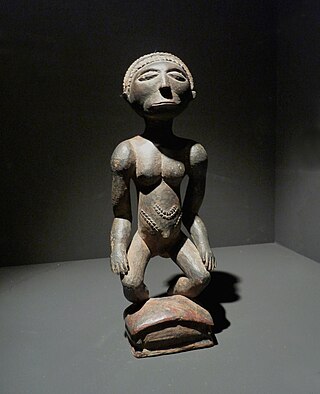
The Holoholo also known as Kalanga are a Bantu ethnic group that inhabit the shores of central lake Tanganyika. The majority of them live near Kalemie city on Lake Tanganyika in Tanganyika Province of the Democratic Republic of the Congo, and on the opposite shore of the lake in Uvinza District of Kigoma Region in Tanzania.
Muhammad bin Khalfan bin Khamis al-Barwani, commonly known as Rumaliza, was an Omani Swahili trader of slaves and ivory, active in Central and East Africa in the latter part of the nineteenth century. He was a member of the Arabian Barwani tribe. With the help of Tippu Tip, he became the Sultan of Ujiji. At one time, he dominated the trade of Tanganyika, before being defeated by Belgian forces under Baron Francis Dhanis in January 1894.
Lake Uniamési or the Uniamesi Sea was the name given by missionaries in the 1840s and 1850s to a huge lake or inland sea they supposed to lie within a region of Central East Africa with the same name.

Baraka, also known as Bala'a, is the main city and metropolitan center of the Fizi Territory located in the South Kivu Province in the eastern region of the Democratic Republic of the Congo (DRC). Baraka is bordered by the Lweba River to the north, the Mutambala River to the south, Lake Tanganyika to the east, and the Lu'e River, Efuma Mountain, and Makundu Mountain to the west.
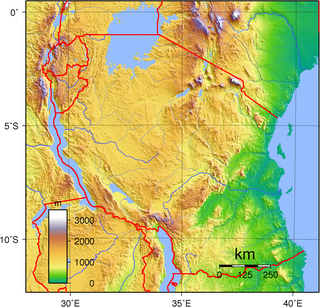
Mainland Tanzania refers to the part of Tanzania on the continent of Africa; excluding the islands of Zanzibar. It corresponds with the area of the former country of Tanganyika.
The Basimba are a Bantu-speaking community in Uganda. The name Basimba is a label of shared identity that predates the 13th century. Basimba has been alternatively associated with the people or their place of origin. The early Ovambo people applied the name to the whole group of the leopard totem clan, known as Bena Ngo in Zambia and Abe Ngo in Uganda.
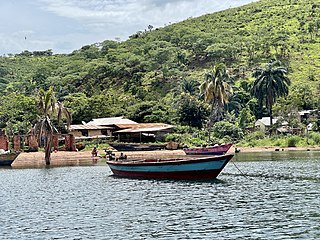
Kigoma District is one of the eight administrative districts of Kigoma Region in Tanzania. The district lies north of the city of Kigoma-Ujiji. Uvinza District, to the west and south of Ujiji, was split off from the Kigoma District in 1 July, 2013.
Mwene Mbonwean Sultanate of Ujiji or Busonga is a subnational Monarchy in Ujiji town, Kigoma Region, western Tanzania. The seat of the local Sultanate is Busaid which was called so from the name of the dynasty of both the Zanzibar Sultanate and Oman which once ruled Ujiji under Arab-Swahili Liwalis, the post Arab name of Busaid for Ujiji proper is still used by the locals as "Busaidi".

Kigoma-Ujiji District is one of the eight administrative districts of Kigoma Region in Tanzania. The District covers an area of 92.7 km2 (35.8 sq mi). It is bordered to the west by Uvinza District in the south east and to the north by Kigoma District. The western shore of lake Tanganyika surrounds the district on the west. According to the 2012 census, the district has a total population of 215,458.











